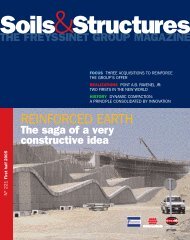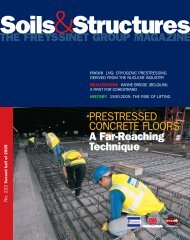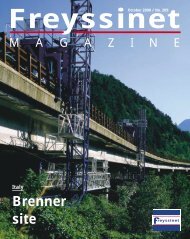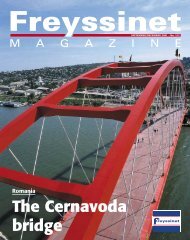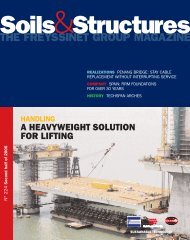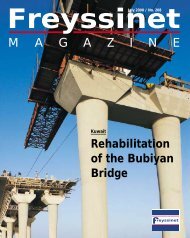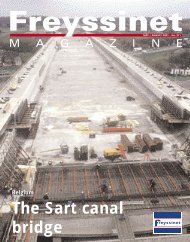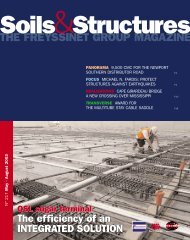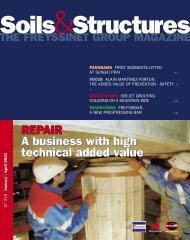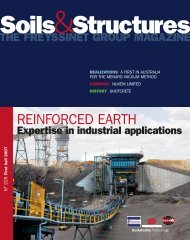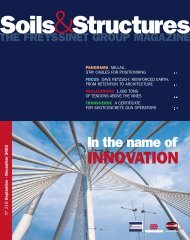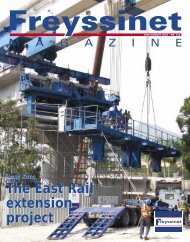STAY CABLE : The System in Top Form N°220 - Freyssinet
STAY CABLE : The System in Top Form N°220 - Freyssinet
STAY CABLE : The System in Top Form N°220 - Freyssinet
Create successful ePaper yourself
Turn your PDF publications into a flip-book with our unique Google optimized e-Paper software.
R E A L I Z A T I O N S<br />
SOILS/BOURGOIN-JALLIEU PLATFORM<br />
A Safe, Simple and<br />
Economical Solution<br />
In Isère (France), the benefits<br />
of an <strong>in</strong>novative solution<br />
proposed by Ménard<br />
<strong>in</strong> jo<strong>in</strong>t-venture led the pack.<br />
HOW CAN LOOSE SOIL BE<br />
IMPROVED to enable it to support<br />
both the dead and operat<strong>in</strong>g<br />
loads of a build<strong>in</strong>g In order to<br />
allow the <strong>in</strong>troduction of a do-ityourself<br />
superstore <strong>in</strong> the Maladière<br />
<strong>in</strong>dustrial zone <strong>in</strong> Bourgo<strong>in</strong>-<br />
Jallieu (Isère, France), this question<br />
was placed before the geotechnicians<br />
of the Experimental Center<br />
for Build<strong>in</strong>g and Public Works<br />
Research and Studies (CEBTP). <strong>The</strong><br />
<strong>in</strong>itial analyses, revealed that the<br />
foundation of the 30,000 m 2 site<br />
comprised a highly compressible,<br />
8 m deep clay-peat layer on top of a<br />
layer of sand and compact gravel.<br />
To prepare the terra<strong>in</strong>, a distribution<br />
mattress (primary backfill)<br />
was placed <strong>in</strong> <strong>in</strong> two zones. <strong>The</strong><br />
first, designed to support the future<br />
slab, was made up of two 30 cm layers<br />
of <strong>in</strong>ert compacted material followed<br />
by 47 cm layer of compacted<br />
gravel laid on an ord<strong>in</strong>ary geotextile.<br />
Over the rema<strong>in</strong>der of the terra<strong>in</strong>,<br />
this distribution mattress was<br />
1.20 m thick made up of a s<strong>in</strong>gle<br />
60 cm layer of <strong>in</strong>ert compacted<br />
material and a 60 cm layer of gravel<br />
laid on a geotextile.<br />
Simplified Design<br />
<strong>The</strong> specifications for soil consolidation<br />
required the <strong>in</strong>stallation of<br />
hard <strong>in</strong>clusions covered with a 1m<br />
thick layer of form and a re<strong>in</strong>forced<br />
concrete slab. Christian Ernst of<br />
Ménard Soltraitement: "Work<strong>in</strong>g<br />
together, Ménard Soltraitement<br />
and Keller-Fondations Spéciales<br />
proposed a solution based on the<br />
use of columns formed of hard<br />
<strong>in</strong>clusions <strong>in</strong> the clay-peat layer<br />
and topped, through the upper 2 m<br />
of backfill, with dry stone columns.<br />
“This method simplified the design<br />
of the structure itself compared to<br />
the orig<strong>in</strong>al solution and made it<br />
possible to avoid "construction of<br />
large re<strong>in</strong>forced concrete slabs that<br />
would have been necessary to<br />
absorb the negative forces caused<br />
by the hard po<strong>in</strong>ts (<strong>in</strong>clusions).”<br />
In addition, these <strong>in</strong>clusions were<br />
at great risk of be<strong>in</strong>g sheared by<br />
the earthworks equipment dur<strong>in</strong>g<br />
the backfill operations. Another<br />
clear advantage of the bi-modulus<br />
PRINCIPLE OF INSTALLATION OF BI-MODULUS COLUMNS (BMC)<br />
columns compared to hard <strong>in</strong>clusions<br />
throughout was their better<br />
resistance to earthquakes. Christian<br />
Ernst tells us: “<strong>The</strong> dry columns<br />
placed on top of the <strong>in</strong>clusions<br />
elim<strong>in</strong>ated the hard po<strong>in</strong>t and<br />
<strong>in</strong>terstitial settlement phenomena.<br />
Thus, the structure is guaranteed to<br />
withstand earthquakes.”<br />
<strong>The</strong> process, with all elements<br />
accurately downscaled, was validated<br />
<strong>in</strong> test specimen assays, cone<br />
penetration tests and <strong>in</strong> situ tests<br />
with 150% overload of the columns.<br />
Measurements performed <strong>in</strong> parallel<br />
illustrated the homogeneity of<br />
settlement throughout the entire<br />
surface.<br />
n<br />
PARTICIPANTS<br />
t t t<br />
Owner: Castorama.<br />
Architect: Paul Barbier.<br />
Specialized Contractor:<br />
Ménard Soltraitement<br />
(project leader) and<br />
Keller Fondations Spéciales<br />
jo<strong>in</strong>t-venture.<br />
20 Soils & Structures Second Semester 2004



